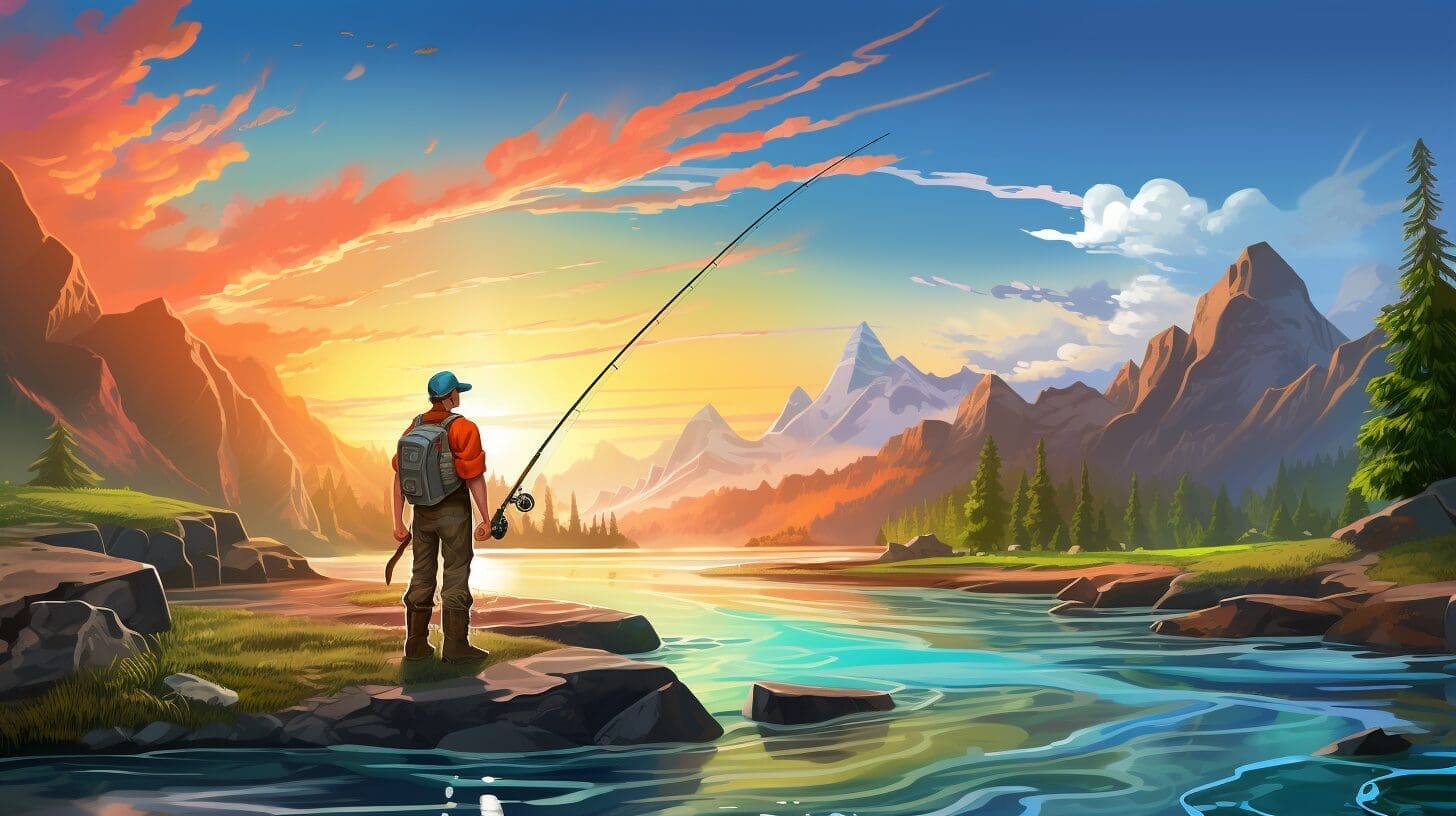Fishing isn’t just a way to catch dinner; it’s a multifaceted hobby that offers a range of benefits, both physical and mental. Whether you’re a complete beginner or someone who’s been fishing for years, the allure of the open water is universal. In this section, we’ll dive into why fishing is an excellent hobby for beginners, backed by the latest statistics and insights.
Physical and Mental Benefits
According to Statista, there are 54.5 million recreational fishing participants in the U.S., and 36% of them are women. The age group with the highest share of participants ranges from 25 to 44. This wide demographic reach suggests that fishing is a hobby that can be enjoyed by nearly anyone, regardless of age or gender.
Fishing offers a plethora of health benefits. It’s a form of exercise that improves cardiovascular health, and the patience required can be a form of mindfulness, reducing stress levels. A study published in PLOS ONE found that during the pandemic, people fished a bit more than usual, citing stress relief, social and family bonding, and being in nature as their primary motivators.
Social Aspects
Fishing is often a social activity, whether you’re going with a group of friends or meeting fellow anglers at your favorite fishing spot. According to Statista, 18% of people take fishing trips alone, while the rest prefer to go in groups. This shows that fishing can be both a solitary and a social hobby, depending on your preference.
Moreover, fishing is a fantastic way to bond with family and friends. It provides an opportunity to disconnect from the digital world and engage in meaningful conversations. During the pandemic, fishing was perceived as a safe, stress-relieving activity, which helped state agencies sell more fishing licenses, according to a study.
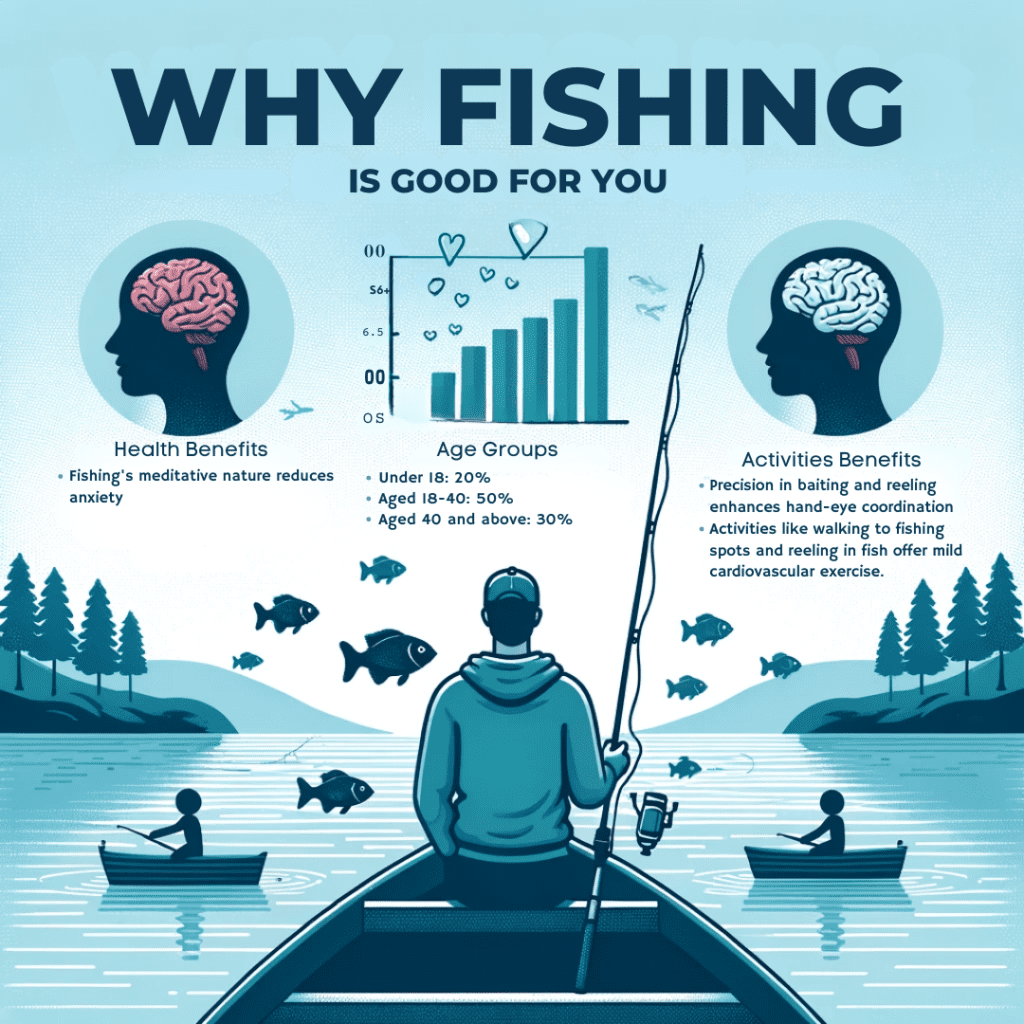
Essential Gear for Fishing Beginners
So, you’re convinced that fishing is the hobby for you. The next step is to get your hands on the essential gear. But with so many options available, choosing the right equipment can be overwhelming. Don’t worry; we’ve got you covered. In this section, we’ll guide you through the must-have gear for fishing beginners, from rods and reels to tackle boxes.
Choosing the Right Fishing Rod and Reel
When it comes to fishing, the rod and reel are your bread and butter. Here are some top picks for 2023:
- BlueFire Fishing Rod Kit
- Type: Carbon Fiber Telescopic Fishing Pole and Reel Combo
- Suitable For: Saltwater and Freshwater
- Price: $36.99

- Dr.Fish Spinning Fishing Rod and Reel Combos
- Type: 7FT Outfit Kit
- Suitable For: Trout, Bass, Freshwater, and Saltwater
- Price: $79.99

Tackling the Tackle
A tackle box is essential for storing all your fishing accessories like hooks, sinkers, lures, and bobbers. Here are some options:
- Fishing Single Tray Tackle Box
- Includes: Sinkers, Hooks, Lures, Bobbers, Swivels
- Price Range: $21.22 – $35.10

- TCMBY Fishing Lures Bait Tackle Kit
- Includes: Crankbait, Spoon, Hooks
- Price: $13.99

Basic Fishing Techniques Every Beginner Should Know
Fishing is an art as much as it is a science. It’s not just about throwing a line into the water and hoping for the best. There are techniques and strategies that can significantly improve your chances of making a catch. In this section, we’ll explore some basic fishing techniques that every beginner should know.
Casting Techniques
Casting is the first step in your fishing adventure. The way you cast can make a significant difference in where your bait lands and how fish perceive it. Here are some popular casting techniques:
- Overhead Cast: This is the most basic and commonly used casting technique. It’s ideal for long-distance casting.
- Side Cast: Useful for casting in areas with obstacles like trees or rocks.
- Roll Cast: Ideal for fly fishing, this technique minimizes the chance of snagging.
Hooking and Reeling
Once you’ve cast your line, the next step is to hook the fish. Here are some tips:
- Setting the Hook: A quick and firm jerk of the rod when you feel a bite.
- Playing the Fish: Keep your line tight and use the rod to guide the fish.
- Reeling In: Use a steady, smooth motion to reel the fish in.
Understanding Fish Behavior
Understanding the behavior of fish can give you an edge. For example, fish are more likely to bite in the early morning or late afternoon. Also, they tend to stay deeper in the water during hot days.
Ethical Practices
It’s crucial to practice ethical fishing. This includes catch and release methods and understanding local fishing regulations. For instance, make sure you’re aware of the fishing license requirements in your state. You can check out state-specific Fishing Licenses, Regulations, and Requirements for more information.
How to Choose the Perfect Fishing Spot
Choosing the right fishing spot is crucial for a successful fishing trip, especially for beginners. The location you pick can significantly impact your chances of making a catch. In this section, we’ll guide you through the factors to consider when choosing the perfect fishing spot.
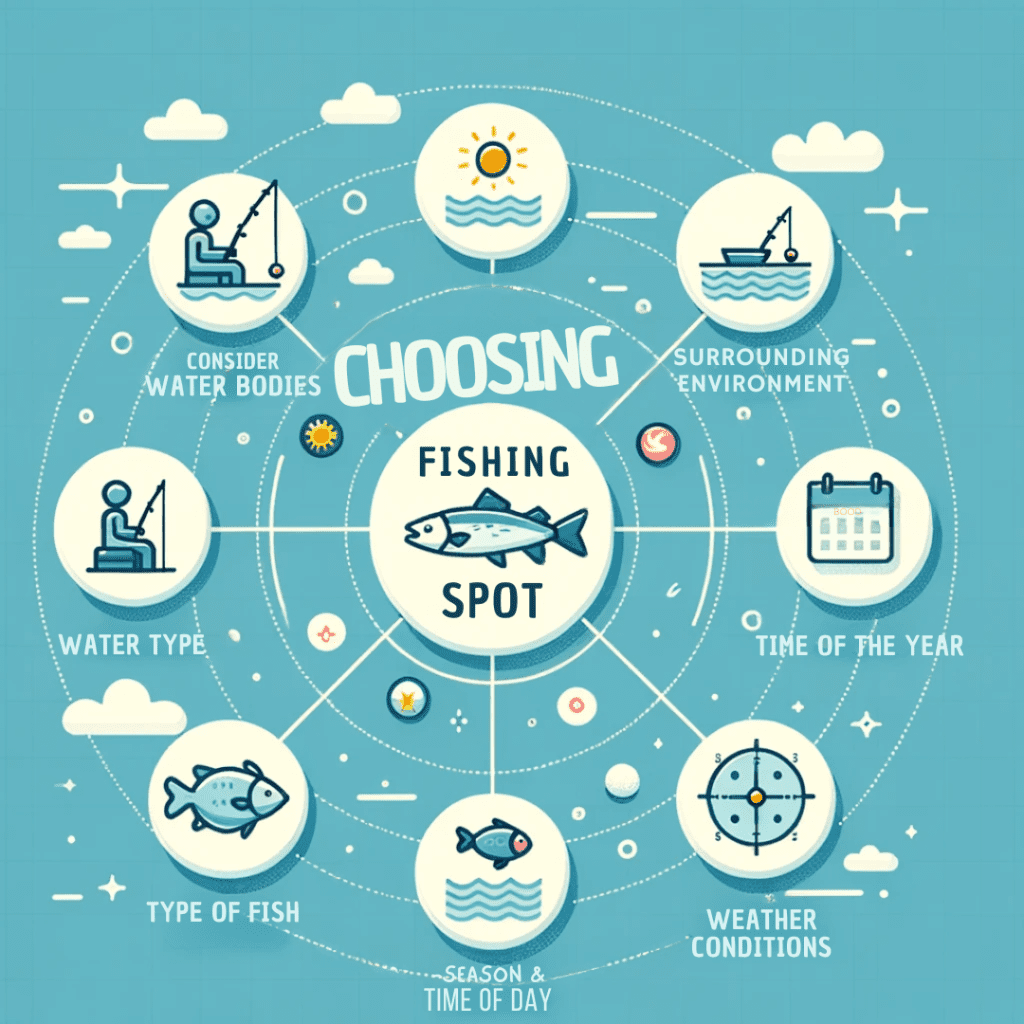
If you’d like to explore Most Popular Fishing Places – just check those set of articles: Popular Fishing Places in the US. Discover detailed information about the best fishing spots across in states, the best tips from experienced anglers, and other expert recommendations.
Types of Water Bodies
Different types of water bodies offer different fishing experiences and are home to various species of fish. Here are some options:
- Freshwater Lakes: Ideal for beginners and home to species like bass, trout, and catfish.
- Rivers and Streams: Great for fly fishing and species like salmon and trout.
- Coastal Areas: For more experienced anglers, targeting species like redfish, snook, and tarpon.
Factors to Consider
- Type of Fish: Knowing the type of fish you want to catch will help you choose the right location.
- Time of Year: Fish are more active during certain seasons.
- Surrounding Environment: Look for natural structures like logs, rocks, or vegetation where fish might hide.
According to Parhunter, a good fishing spot depends on several factors such as the type of fish you’re targeting, the time of year, and the surrounding environment. Research local lakes, rivers, or coastal areas to find a suitable location. Online resources, fishing apps, and talking to experienced anglers can provide valuable insights.
Local Regulations and Permits
Before heading out, make sure you’re aware of the local fishing regulations. Failure to comply can result in fines. Check out state-specific Fishing Licenses, Regulations, and Requirements for more information.
Preparing for Your Fishing Trip
Before you head out on your fishing adventure, proper preparation is key. From packing the right gear to considering the weather, each element plays a crucial role in how enjoyable and successful your trip will be. Let’s dive into what you need to know.
What to Pack: Essentials and Extras
Packing for a fishing trip can be a daunting task, especially for beginners. However, a well-packed bag can make your trip much more enjoyable. Here’s what you should consider packing:
- Fishing Gear: Rods, reels, hooks, and lures are the basics.
- Clothing: Dress in layers and consider the weather. A good waterproof jacket is a must.
- Personal Items: Don’t forget essentials like sunscreen, hats, and sunglasses.
- Safety Gear: Life jackets, first aid kits, and maps or GPS devices are crucial.
- Food and Water: Always pack enough food and water to last the entire trip.

According to Asher & Lyric, the weather you’ll encounter depends on your destination and the time of year. Dressing in layers is often recommended, and don’t forget to pack a life jacket if you’re fishing from a boat.
Weather Considerations: Dressing for Success
The weather can be unpredictable, so it’s best to be prepared for all conditions. Whether it’s hot, cold, rainy, or sunny, dressing appropriately can make or break your trip.
- Spring and Fall: Layer up to adjust to varying temperatures.
- Summer: Prepare for the sun with sunscreen, hats, and sunglasses.
- Winter: Dress in warm layers and don’t forget gloves and a beanie.
Safety Measures: What You Need to Know
Safety should be your top priority when going fishing. Here are some safety measures to consider:
- Fishing License: Always have a valid fishing license. Check out Fishing License Costs in Each State for more information.
- First Aid Kit: Always carry a basic first aid kit for minor injuries.
- Communication: Ensure you have a way to communicate in case of emergencies, such as a fully charged phone or radio.
Your First Fishing Trip: Step-by-Step Guide
Embarking on your first fishing trip can be both exciting and a bit overwhelming. With the right guidance, however, you can turn it into an unforgettable experience. Here’s a step-by-step guide to help you navigate through your first fishing adventure.
Arriving at the Fishing Spot
The first step is to arrive at your chosen fishing spot. Whether it’s a lake, river, or ocean, each type of water body offers a unique fishing experience. Fishing Sensei says that lakes are a great starting point as they are home to a variety of game fish like bass, trout, and panfish. Rivers are also an excellent choice, especially if you’re targeting trout or salmon.
- Parking: Find a safe and legal place to park your vehicle.
- Survey the Area: Take a few minutes to observe the water and identify potential fishing spots.
- Set Up Base: Choose a comfortable spot where you can set up your fishing gear.
Setting Up Your Gear
Once you’ve settled in, it’s time to set up your fishing gear. A light-power, fast-action rod is recommended for beginners. Pair it with a spinning reel for an effective setup.
- Assemble the Rod: Attach the reel to the rod and thread the fishing line.
- Prepare the Hook and Bait: Attach the hook and select the appropriate bait for the fish you’re targeting.
- Test the Gear: Make a few practice casts to ensure everything is working as it should.
Casting and Waiting
Now comes the moment of truth—casting your line into the water and waiting for a bite.
- Casting Technique: Use the overhead or sidearm casting technique based on your comfort level.
- Patience is Key: Fishing is a waiting game. Keep an eye on the float and be patient.
- Be Alert: Watch for any movement or tugs on your line, signaling a potential catch.
Common Mistakes to Avoid
Fishing can be a rewarding experience, but it’s easy to make mistakes when you’re just starting out. Here are some common pitfalls to avoid, so you can make the most of your fishing adventure.
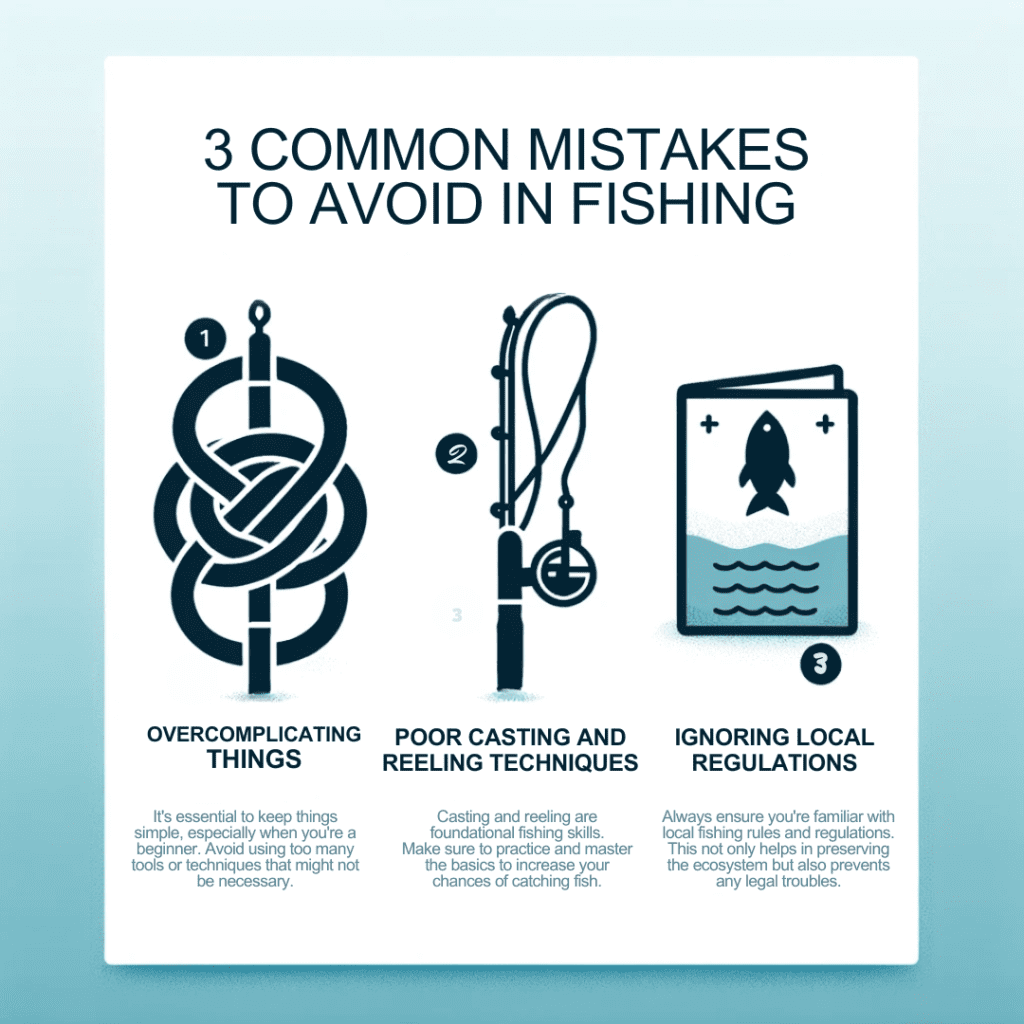
1. Overcomplicating Things
Many beginners think they need the latest and most expensive gear to catch fish. However, a simple setup is often more effective, especially when you’re learning. All you really need is a basic rod, reel, and some bait to get started.
Tips:
- Stick to basic gear initially.
- Learn the fundamentals before diving into advanced techniques.
2. Poor Casting and Reeling Techniques
Poor casting and reeling can scare away fish and make your fishing trip less successful. We suggest practicing your casting in an open field before hitting the water.
Tips:
- Practice makes perfect; don’t hesitate to practice casting.
- Be mindful of your surroundings to avoid tangling your line in trees or shrubs.
3. Ignoring Local Regulations
Fishing regulations vary by location and not following them can result in fines or even confiscation of your gear. Always check local fishing laws and obtain the necessary permits. Our article on Fishing License Costs in Each State can be a good starting point.
Tips:
- Always carry your fishing license.
- Be aware of fishing seasons and size limits for different species.
Fishing Etiquette: Do’s and Don’ts
Fishing is not just about casting a line; it’s also about respecting the environment and those around you. Proper fishing etiquette ensures a pleasant experience for everyone involved. Let’s explore some of the do’s and don’ts that every angler should be aware of.
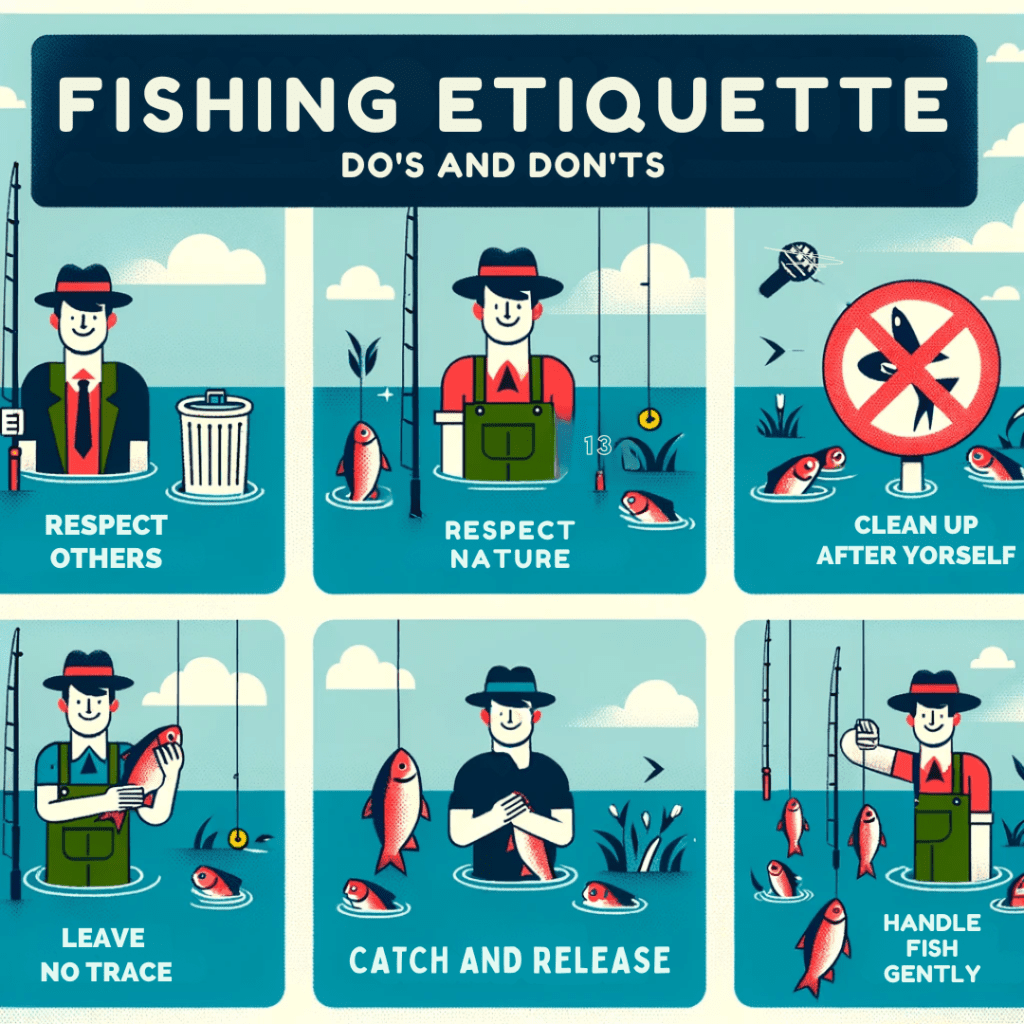
Respecting Other Anglers
When you’re out fishing, it’s crucial to respect other anglers’ space and experience. If you see someone fishing, give them some space. If you’re wade fishing or shore fishing, maintain at least ten feet between you and fellow anglers.
Tips:
- First come, first serve; don’t encroach on someone else’s spot.
- Be mindful of your casting; don’t cross lines with nearby anglers.
Environmental Responsibility
Taking care of the environment is a collective responsibility. Angling Fun emphasizes the importance of cleaning up after yourself. Dispose of any trash or fishing line properly to keep our waterways clean.
Tips:
- Pack it in, pack it out; don’t leave trash behind.
- Be mindful of the natural habitat; don’t disturb shrubs or branches.
Ethical Fishing Practices
Ethical fishing practices are essential for the sustainability of fish populations. Always follow local fishing rules and regulations. As per Nebraskaland Magazine, it’s important to know what type, how many, and what size fish you can keep.
Tips:
- Always carry a valid fishing license.
- Follow catch-and-release orders where applicable.
Catch and Release or Keep
One of the most debated topics among anglers is whether to catch and release or keep the fish. Both approaches have their merits and drawbacks, and the choice often boils down to personal preference, ethics, and local regulations. Let’s delve into the intricacies of each.
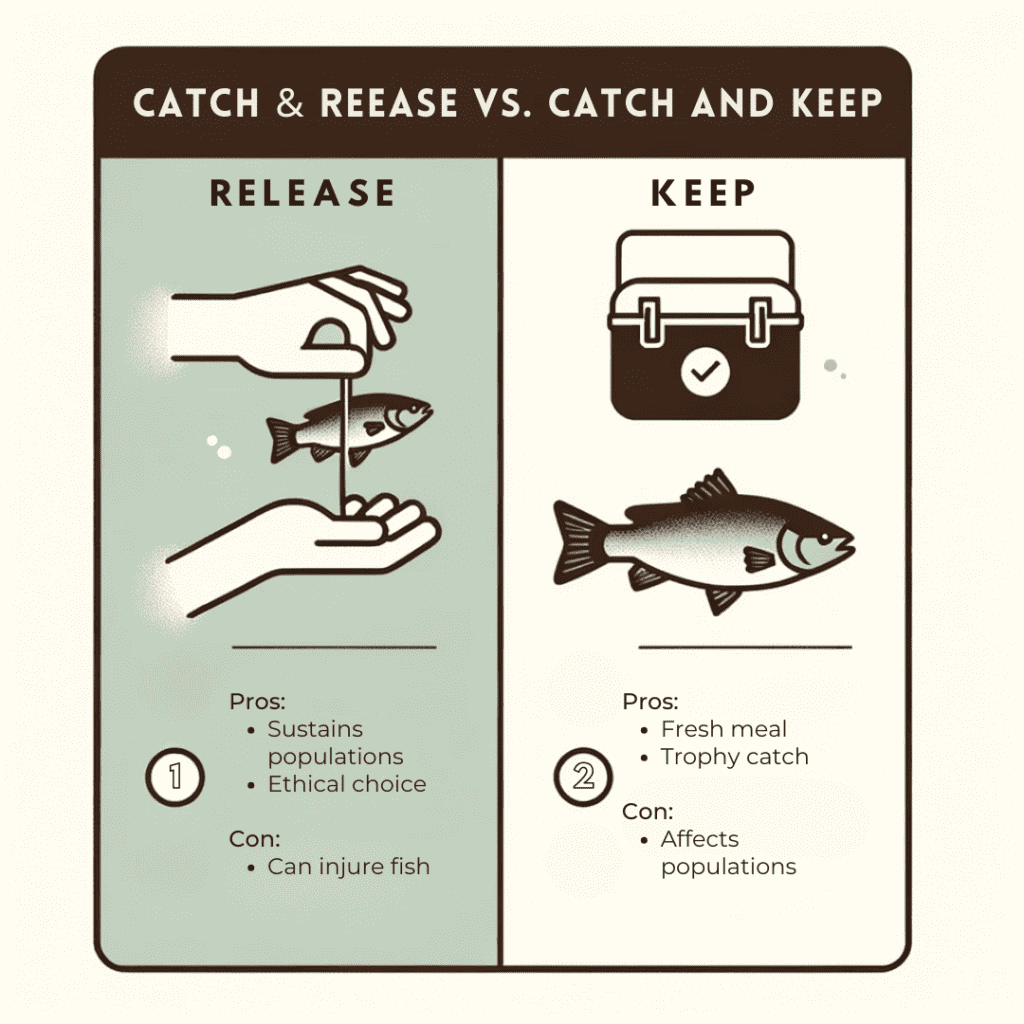
Ethics and Regulations of Catch and Release
Catch and release is a conservation strategy aimed at maintaining healthy fish populations. According to NOAA Fisheries, the technique involves immediately releasing the fish back into the water after catching it. However, it’s not just about letting the fish go; how you handle the fish before, during, and after the catch can significantly affect its chances of survival.
Tips:
- Use gear that minimizes stress to the fish, such as circle hooks or barbless hooks.
- Handle the fish as little as possible and only with wet hands.
- If the fish shows signs of barotrauma (e.g., bulging eyes, bloated midsection), use recompression tools to release it at depth.
Keeping the Fish: What You Need to Know
On the other hand, catch and keep fishing has been a part of human history for thousands of years. As Baitium points out, it’s a way to connect with our ancestors and appreciate the environment. However, this approach comes with its own set of responsibilities.
Tips:
- Always follow local fishing regulations, including size and bag limits.
- Be sustainable; only keep what you can consume.
- Be mindful of bycatch and non-target species.
Properly Storing Your Catch
If you decide to keep the fish, proper storage is crucial to maintain its freshness and quality.
Tips:
- Use a cooler with ice to store the fish immediately after catching it.
- Clean the fish as soon as possible if you intend to consume it.
Conclusion
Fishing is an activity that anyone can enjoy regardless of age, gender, or experience level. For beginners, it offers the chance to immerse yourself in nature, learn a new skill, and reap the mental and physical benefits of an engaging hobby. While it may seem daunting at first, starting with the basics like acquiring a simple rod and reel setup, choosing a suitable fishing spot, and learning fundamental casting techniques can set you up for success.
Remember that patience and perseverance are key when you’re new to fishing. Don’t get discouraged if you don’t get a bite right away. Observe other anglers, ask questions, and keep practicing your technique. You’ll likely make some mistakes in the beginning, whether it’s improper casting or ignoring local regulations. However, these missteps are all part of the learning process. Maintain a positive attitude, adhere to ethical practices, and you’ll be reeling in fish before you know it.
Fishing is ultimately meant to be an enjoyable activity. While catching fish is rewarding, focus more on the entire experience. Appreciate the peacefulness of the outdoors, the excitement of getting a bite, and the new skills you’re acquiring. Share your experiences and knowledge with family and friends, introducing them to the sport. Whether you decide to catch and release or keep some for a meal, remember that maintaining healthy ecosystems and fish populations should always be the priority for anglers. Follow local guidelines, be mindful of your impact, and you can make fishing an enriching, sustainable, and rewarding lifelong hobby.

